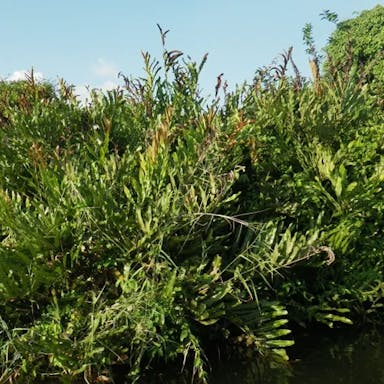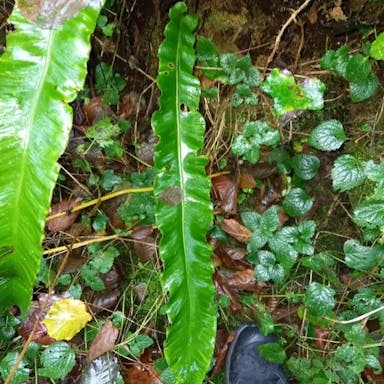Delta maidenhair fern, scientifically known as Adiantum raddianum, is a popular plant in the Adiantum genus. The fern has delicate fronds in a fan-like pattern. The fronds are typically green. This fern does not make flowers. It grows new plants from spores under the fronds. The spores spread and help the fern thrive. People like to grow Adiantum raddianum indoors. It needs bright, indirect light and soil that drains well. Humid places help it grow, like bathrooms and kitchens. This fern grows 12-24 inches high. It fits nicely in many spaces. Some believe this maidenhair fern is graceful and feminine. It may make a calm feeling in a room. Also, it can purify indoor air. Overall, it is a beautiful and easy fern for indoors.
Delta maidenhair fern
- Scientific name
- Adiantum raddianum
Basic Information
- Pteridaceae Family Adiantum Genus Delta maidenhair fern Species
- Pteridaceae > Adiantum > Adiantum raddianum
- 83%
- The Completeness of This Encyclopedia
Please help us complete the encyclopedia, Terrarium is a encyclopedia service to be completed with everyone in the world. Currently, this page is 83% complete. For more information on how to contribute, please click here.
- Pteridophyta
- Height
- 30cm ~ 60cm
- Flower Color
- Leaf Color
- Anthesis
- Sunlight Exposure
Full Sun Long hours of sunlight from morning to afternoon Partial Shade A location in the shade of a tree or where either the morning or afternoon is shaded Full Shade A place where there is no direct sunlight
- Partial Shade
- Hardiness Zones
This is an indicator to know to which zone each plant can winter. Knowing the zone of each plant gives you an idea of the cold temperature resistance when grown in the ground without a roof. 2: -42.7 to -40.0 3: -39.9 to -34.4 4: -34.3 to -28.9 5: -28.8 to -23.3 6: -23.2 to -17.8 7: -17.7 to -12.2 8: -12.1 to -6.7 9: -6.6 to -1.1 10: -1.0 to 4.4 11: 4.5 to 10.0
- 10-11
- Cold resistance
- Poor
- Heat resistance
- Good
- Habitat of origin
- South America
- Growth Rate
- Normal
What is Delta maidenhair fern (Adiantum raddianum)?
What is Delta maidenhair fern (Adiantum raddianum)
Flower meaning
The flower language commonly associated with the Delta maidenhair fern in America is
Calendar of Delta maidenhair fern (Adiantum raddianum)
Calendar
Delta maidenhair fern (Adiantum raddianum) is a plant species native to the United States. Leaf cutting is a common method used to propagate the Delta maidenhair fern from a healthy parent plant. The cutting should be taken near the base of the frond for best results. New plants will begin to grow at the nodes of the cutting. Frequent misting helps the new plants acclimate. The Delta maidenhair fern is a tropical plant that enjoys warm temperatures and high humidity. It should be watered frequently to keep the soil moist but not soggy. Allow the top inch of soil to dry out between waterings. Delta maidenhair ferns can be prone to leaf spot diseases if water sits on the leaves. Good air circulation helps prevent disease. This easy to grow fern makes an excellent houseplant. Its lacy green fronds provide an airy, delicate texture. For best results, provide the Delta maidenhair fern with bright, indirect sunlight.
How to grow Delta maidenhair fern (Adiantum raddianum)
Watering
The Delta maidenhair fern depends on various factors. It prefers moist soil during the growing season, from spring to fall. Avoid overwatering, as this leads to root rot. To maintain ideal soil moisture, water the fern deeply once a week so water penetrates the root zone. The amount of water varies based on the fern's size and conditions, but provide around 1 inch per week. During winter dormancy, water less frequently. Allow the top soil to dry out between waterings to prevent waterlogging. Monitoring soil humidity and adjusting watering accordingly is crucial for the Delta maidenhair fern health.
Soil and Fertilizer
Delta maidenhair fern, scientifically known as Adiantum raddianum, thrives in well-drained soil with a slightly acidic to neutral pH level ranging from 5.5 to 7.0. It prefers soil that is rich in organic matter and has good moisture retention capabilities. The fern requires a soil that is loose and well-aerated to promote root growth and prevent waterlogging. Apply fertilizer with a ratio of 10-10-10 or 14-14-14 during the growing season, typically spring to early fall. Apply every 4-6 weeks, following manufacturer's instructions for recommended amount. Before applying, water thoroughly so nutrients absorb properly. Avoid over-fertilizing, which can lead to salt buildup and harm the fern. Regularly monitor soil pH and quality to maintain optimal conditions. Make pH adjustments using organic amendments like peat moss or compost. Periodic soil testing can identify nutrient deficiencies, allowing targeted fertilization.
Sunlight and Place
Separate lines after 2 sentences. Delta maidenhair fern (Adiantum raddianum) is a happy plant that wants filtered sunlight or half shade. It is not forgiving of direct sun, as it can scorch the delicate leaves. This fern has a medium coldness tolerance, with an best temperature range of 60-75°F (15-24°C). It can deal with coldness as low as 50°F (10°C) but may be damaged if touched by freezing coldness. For heat tolerance, Delta maidenhair fern likes below 85°F (29°C) and may have problems in hot and wet climates. In summer, it is best to keep the fern in a cool and shaded area to stop heat stress. In winter, it can deal with a bit cooler, but it is key to avoid exposing it to air currents or cold air. Overall, Delta maidenhair fern grows well in a lighted area with filtered sun and medium temperatures.
Advanced Information of Delta maidenhair fern (Adiantum raddianum)
Pruning
Delta maidenhair fern, scientifically known as Adiantum raddianum 'Delta', benefits from regular pruning and cutting back to maintain its health and appearance. Regular cleaning is essential to get rid of infected parts or damage. Also, trimming can facilitate controlling size and silhouette, stopping development overly large. The ideal time to trim Delta maidenhair fern is in early springtime or late wintertime, preceding new development starts. Throughout this period, the greenery is sleeping, causing it less susceptible to difficulty. When cleaning, it is crucial to apply sanitized, sharp shears for neat cuts and reducing disease probability. For trimming Delta maidenhair fern, begin by eliminating any lifeless portions at the foundation. Cut away from the live green material. If the fern is overly expanded, also trim outer parts to sustain a compact form. After trimming, it is vital to supply appropriate care to encourage recuperation. This involves routine hydrating, ensuring the earth is damp but not waterlogged. Also, providing indirect sunlight and humidity can assist development and health. In summary, regular trimming of Delta maidenhair fern is required for health, aesthetics, and size control. Trimming should occur in early springtime, using sanitized, sharp shears. After trimming, provide care to assist recovery.
Planting and Harvest
Delta maidenhair fern, also known as Adiantum raddianum, is a well-liked green for inner growing. Most suitable for pot growing than ground growing. To pot the Delta maidenhair fern, select a container with good water flow and fill with a well-draining mix. Gently take away the fern from it's nursery holder, taking care not to harm the delicate leaves. Place the fern in the middle of the pot and fill in gaps with more mix. Water thoroughly after potting and place somewhere with bright, indirect light. For repotting, select a somewhat bigger container and follow identical procedure as potting. Repotting is typically accomplished every 1-2 years or when plant becomes bound. Mist regularly to maintain wetness, as it prefers damp conditions. Avoid overwatering, as this can lead to decay. Feed monthly during growing season with a balanced liquid feed. With proper care, the Delta maidenhair fern can grow well as a stylish addition to any indoor space.
Propagation
Delta maidenhair fern is called Adiantum raddianum. It can be increased by sowing seeds, division, cuttings, and leaf cuttings. To increase by sowing seeds, gather ripe spores from the fronds. Sow them on a damp, sterile growing medium. Cover the container to maintain humidity. Place it somewhere warm with indirect light. Keep the medium moist. Soon, tiny ferns will start to emerge. For division, carefully separate the rhizomes of an established plant into smaller sections. Ensure each section has roots and fronds. Plant these in individual pots with well-draining soil. Keep them in a shaded area and water regularly. Soon, new growth will appear. For cuttings, take stem cuttings with at least two leaves. Dip the cut end in rooting hormone and plant in a pot with well-draining soil. Place the pot somewhere warm and humid with indirect light. Keep the soil moist and soon, roots will develop. Leaf cuttings can also be used. Take a healthy leaf and cut it into sections with a leaf blade piece and small petiole piece. Plant these in a pot with well-draining soil. Keep them somewhere warm and humid with indirect light. Mist the cuttings regularly and soon, new plants will grow. Harvesting is not needed for increasing the plant through various methods.
Pests and Diseases
Delta maidenhair fern (Adiantum raddianum) is vulnerable to some pests and diseases. One very common pest is the insect, which sucks the plant's sap and makes stunted growth and yellowing of leaves. Insects can be controlled by checking the plant regularly and using soap or oil to eliminate them. Another pest is the scale bug, which forms small, shells on the plant's stems and leaves. Scale bugs can be removed by gently scraping them off with a soft brush or cloth, or by using oil. The fern is also likely to fungal diseases such as spot and mildew. Spot appears as dark, wet spots on the leaves, which turn brown and make leaf withering. Mildew, on the other hand, shows as a white, coating on the leaves. Both diseases can be prevented by ensuring air circulation around the plant, avoiding overhead watering, and removing infected leaves. Chemicals may also be used as a last resort. Overwatering and poor drainage can lead to decay, which makes the plant's roots decay and the leaves to wilt. To prevent decay, it is important to allow the soil to dry out between waterings and to use draining soil. Additionally, avoiding overcrowding of plants and providing light can help keep the fern healthy and reduce the risk of pests and diseases.
Habitat of Delta maidenhair fern (Adiantum raddianum)
Habitat
Toxicity of Delta maidenhair fern (Adiantum raddianum)
Health Benefits
- edible
- Inedible
- Toxic
- No toxicity
NO DATA
Toxic for dogs and cats
NO DATA
Q&A of Delta maidenhair fern (Adiantum raddianum)
- Is there a recommended way to choose Delta maidenhair fern?
Delta maidenhair fern, scientifically known as Adiantum raddianum 'Delta', is a popular fern variety known for its delicate, lacy fronds. Look for healthy plants with vibrant foliage and no disease when choosing Delta maidenhair fern seedlings. The leaves should be well-shaped and evenly spaced. Stay away from plants with yellowing or drooping leaves, as this can indicate poor health. When buying Delta maidenhair fern seeds, pick good suppliers that provide new, top-notch seeds. Look for plump, firm seeds, showing good possibility to grow. Keep away from discolored, wrinkled, or damaged seeds. It's vital to note that Delta maidenhair fern is mostly spread through division instead of seeds. So, it may be more common to find young plants rather than seeds for this variety. In general, selecting strong and high-grade Delta maidenhair fern plants or seeds is key for successful growth and establishment of this beautiful fern in your garden or inside.











